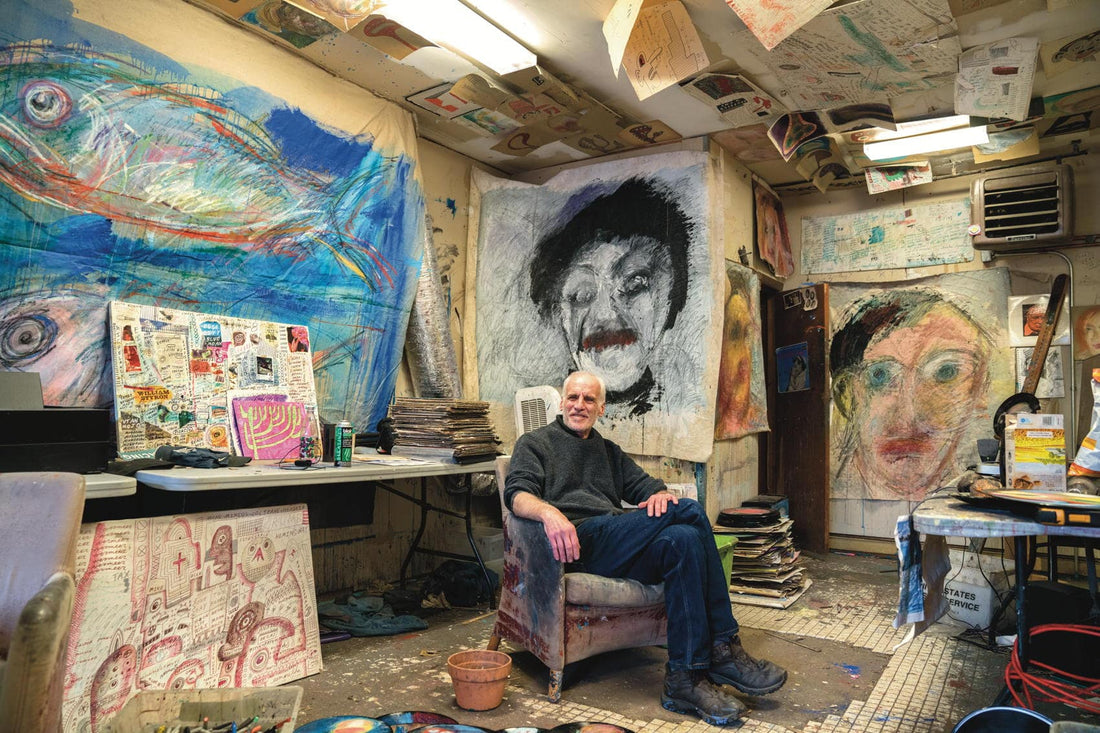First published: Fall 2023
Discarded, reclaimed, reworked – on loop – the paintings of Jon Sarkin reveal their own physical history, as well as dissonant dialogues and jazz-like riffs
Jon Sarkin’s Coltrane (2006) is a characteristic mix of image and text. It is dominated visually by a block of viridian green ink, roughly blocked in at the top, and ending in vertical drips. Taken together, the form resembles chimneys belching filthy smoke. An urban setting is seemingly confirmed by spare architectural marks. Any sense of simple pictorial space is disrupted, though, by a liberal use of text, including an eclectic namecheck of artists, writers and musicians important to Sarkin, as well as an apparently random reference to the French luxury winery, Moët. The work was produced in several sittings, beginning with some ink drawing, and ending with the addition of a quote from a Bob Dylan lyric from Absolutely Sweet Marie (1966), written in silver marker pen over the green “cloud”. Besides Dylan, musical artists include Mose Allison and, of course, John Coltrane.

Sarkin in his Gloucester studio in February 2023, photo: Ted Degener
The artists here are mostly classic European Modernists: Pablo Picasso, Paul Klee and Kurt Schwitters, although, in other Sarkin works, viewers are just as likely to encounter old masters like Rembrandt and Vermeer, or contemporary artists like Robert Rauschenberg and Jean-Michel Basquiat. The writers include Hunter S Thompson and, by inference (through the word “Howl”), Allen Ginsberg. Between them, this dramatis personae speak simultaneously to Sarkin’s broad, deep cultural interests and to his profoundly stream-of-consciousness approach to art-making – something that he experiences as existential imperative, rather than as a simple choice.

Ark, 2005, mixed media on canvas, 30 x 23 in. / 76 x 58.5 cm, courtesy: Jon Sarkin
Sarkin only embraced the vocation of artist in his mid-thirties. Yet, it is hard not to imagine that destiny had always had him marked out for it. Born in 1953 in Newark, New Jersey, to a resolutely non-artistic family, Sarkin seems to have been encouraged to fight against his creative urge from an early age. He dutifully completed his studies in biology at the University of Pennsylvania and environmental science at Rutgers, New Jersey, before training as a chiropractor. Yet, in what turned out to be a kind of apprenticeship, he also drew a lot in his spare time and, as a teenager, learned to play guitar.

Bosch (2020), pen, permanent marker and ink wash on foamboard, 30 x 20 in. / 76 x 51 cm, courtesy: Henry Boxer Gallery
He voraciously imbibed the work of countercultural artists like Robert Crumb, read widely, including Jack Kerouac and Thompson, and was a regular visitor to music haunts in New York City, notably the Fillmore East, where he saw some of the great rock and blues acts in their prime. When he settled and established a chiropractic practice, it was in Cape Ann, Massachusetts, which coincidentally has been a magnet for artists, writers and musicians since the nineteenth century. He worked conscientiously and contentedly at his chosen profession. Jamming on his guitar with friends in a local club was among the only outwardly creative outlets he allowed himself.
At the end of the 1980s, everything changed. A medical procedure to cure chronic tinnitus led to a catastrophic stroke that destroyed much of the left half of Sarkin’s brain. In the first months, there were several times when it seemed he might not survive, and when his recovery began, it was clear that much was different. He faced a number of physical challenges, including deafness in his left ear, double vision, and difficulties with coordination which meant, among other things, that he could no longer play guitar. Sarkin also experienced a kind of epiphany; from that time on, he was driven by an overwhelming need to make art above all else.
by COLIN RHODES
This is an article extract; read the full article in Raw Vision #116.




